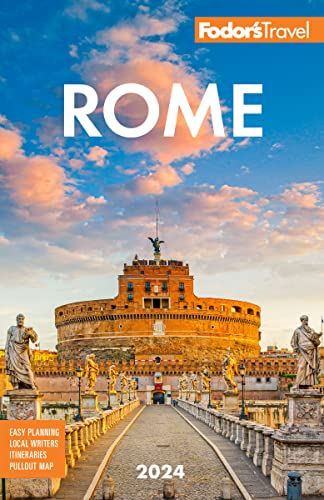Rome Today
Rome, the Eternal City, is 28 centuries old and yet is still constantly reinventing itself. The glories of ancient Rome, the pomp of the Renaissance Papacy, and the futuristic architecture of the 20th and 21st centuries all blend miraculously into a harmonious whole here. The fact that you can get Wi-Fi in the shadow of 2,000-year-old ruins sort of sums things up, and it’s this fusion of old and new and the casual way that Romans live with their weighty history that make this city so unique.
The 21st Century
Rome has changed a lot, relatively speaking, since the millennium. Much of the centro storico (historic center) has been pedestrianized or has had its access limited to residents, public transport, and taxis, so you can now stroll around landmarks like the Pantheon, the Trevi Fountain, and the Spanish Steps without having to dodge a constant stream of traffic. One radical change for Italy is that smoking is banned in all public places, including restaurants and pubs. And central areas such as Monti, Testaccio, and San Lorenzo have become gentrified or arty-chic, so you can extend your sightseeing range to spots tourists wouldn't have dreamed of visiting back in the 1980s or ’90s.
Multiculturalism
While nowhere near as diverse as cities such as London and Paris, spend a day in Rome's Esquilino neighborhood, for instance, and you'll see that the Eternal City is slowly becoming more cosmopolitan. Once famous for its fruit and vegetable market at Piazza Vittorio, Esquilino has fast become a multiethnic stomping ground, with a vast array of Chinese, Indian, African, and Middle Eastern restaurants. The now world-famous Orchestra of Piazza Vittorio, made up of 16 musicians from North Africa, South America, the Caribbean, Eastern Europe, and Italy, got their start in this district just steps from Rome's Termini station and now perform at festivals around the world. It's worth noting, too, that Rome, the stronghold of Roman Catholicism, is also home to one of the largest mosques outside of the Islamic world. Located near the elegant Parioli district, the Mosque of Rome opened in 1995 and welcomes visitors of all faiths.
New Architecture
Rome may be firmly anchored in the distant past, but that's never been an obstacle to its journey into the new millennium. Just look at some of the architectural marvels that have emerged in the last 20 years: the Auditorium Parco della Musica (Renzo Piano, 2002), the new Jubilee Church (formerly Chiesa di Dio Padre Misericordioso; Richard Meier, 2003), the Museo dell’Ara Pacis (Richard Meier, 2006), and the MAXXI—Museo Nazionale delle Arti del XXI Secolo (Zaha Hadid, 2010). In 2011, Rome also built a new bridge: the grandiose Ponte della Musica over the Tiber River. The eco-friendly bridge, which looks like two giant white harps rising from the ground, can be used only by pedestrians and cyclists. And the Massimiliano Fuksas–designed Roma Convention Center, nicknamed "La Nuvola" for its futuristic suspended cloud shape, finally opened in 2016.
New Transportation Lines
Romans are anxiously awaiting the completion of the new Metro Linea C, which will cut through the city center at Piazza Venezia and link with both the A and B lines at Ottaviano for St. Peter’s and the Colosseum, respectively. Expected to considerably ease surface-traffic congestion, progress on the new line has gone slowly, because every time a shaft is sunk in Roman ground, it reveals some new important archaeological site and all work halts for the ensuing excavation. Currently only the peripheral section of Line C is running, from Lodi eastward.
In addition, Italo, Italy’s first private railway, now gives travelers an alternative to the high-speed Frecciarossa service offered by state-run Trenitalia. Both Italo and Trenitalia trains leave from Termini and the newly restructured Tiburtino station, connecting Rome with most of Italy’s other major cities. Journey times are roughly the same, but Italo can be cheaper, especially when booking in advance online. Italo trains are fancier, especially in first class and above, and amenities include leather seats by furniture designer Poltrona Frau and free (although rather spotty) on-board Wi-Fi.
What's New
Over morning cappuccinos Romans love especially to talk about two things: sports and politics. As a sort of ritual greeting, Romans discuss the latest news about the city's two soccer teams and the latest political scandal.
In the world of sports, the supporters of the football teams (that's soccer to Americans) Roma and Lazio are bitter enemies. Hostilities between fans of these two teams peak twice a year, during the “derby,” the direct matches between the two teams. If you happen to be in Rome at this time, you'll witness surreal and unusual silences periodically overtaking the city, only to be broken by thunderous screaming and shouting when a goal is scored.
Politics-wise, after the controversial era of Silvio Berlusconi, Romans first embraced the young prime minister, Matteo Renzi when he gained power in 2014. The 39-year-old center-left politician was the youngest head of government Italy has ever had. But the recent tide of populism spreading through Europe reached Italy in late 2016, when a constitutional referendum to amend parts of the Italian Constitution was overwhelmingly defeated by voters and Renzi stepped down in response to what he saw as a vote against his government. In 2018, Giuseppe Conte was appointed PM, head of a newly formed coalition made up of the populist Five Star Movement and the right-wing Northern League, united by their anti-immigration policies. Eyes are on Italy now to see how the new government will play out in the midst of an ever-changing Europe.




